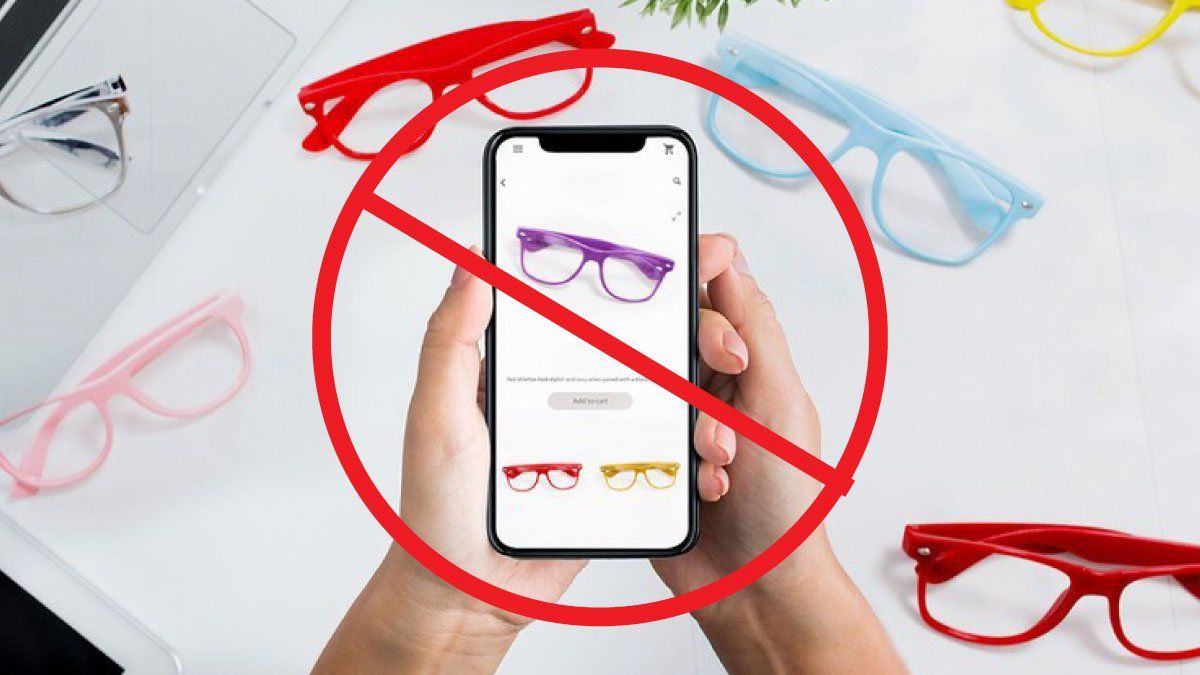Think Twice About Buying Eyewear Online

Read time: 4 minutes
The majority of us live in a highly visual world and our eyesight is essential to our interpretation of that world. Imagine what life would be like without our vision. It is truly a special gift that should be preserved with care and not sacrificed for the sake of saving money.
In an era where convenience is king, online shopping has taken the throne as the reigning champion of retail therapy. With just a few clicks, you can have your favorite products delivered right to your doorstep. No more long lines, crowded stores, or even the need to leave your couch. It all sounds too good to be true, doesn't it?
The biggest thing to remember is that glasses are medical devices. Frames aside, the lens is truly the most important component of the eyewear choice. Lenses should be chosen under the direct supervision of an optometric medical professional.
Before Shopping Online
While online shopping offers undeniable advantages, there are some important factors you might be overlooking.
Before you eagerly click "Add to Cart" again, let's explore the hidden costs and potential pitfalls of online shopping that could leave you feeling like you got more than you bargained for. Having knowledge about the risks will help make your virtual purchases a safer and more satisfying experience.
Before you start shopping online, here are some questions to ask yourself:
- How will you choose?
- How will they fit and will they work with your prescription?
- Do you want to trust your eyesight to someone you don’t know?
- If you’re unhappy with the eyeglasses, who will help?
Costs & Pitfalls of Buying Online
Shipping Costs Can Sneak Up on You
That "free shipping" offer may not be as cost-effective as you think. Retailers often set minimum purchase thresholds for free shipping, and these thresholds can lead to unnecessary overspending. Additionally, expedited shipping, if required, can quickly add up to your order's total cost. It's essential to evaluate whether the shipping costs outweigh the convenience of staying home.
Tip: Before completing your purchase, compare the cost of shipping to that of traveling to a local store. You might find that the latter is more economical, especially for smaller, less urgent items.
Return Hassles and Restocking Fees
Online shopping doesn't allow you to touch, feel, or try on products before you buy. When the item you receive doesn't meet your expectations, returns become a hassle. Many online retailers charge restocking fees, and some may even require you to cover return shipping costs. It's crucial to familiarize yourself with the store's return policy before making any purchases.
Tip: Only shop from retailers with a flexible and customer-friendly return policy. Some offer free return shipping, and others have lenient return windows.
Impersonal Customer Service
While online retailers have made significant strides in improving customer service, it can still be challenging to resolve issues quickly or effectively when you're communicating through chatbots or emails. Face-to-face interaction is often absent, which can make problem resolution feel less personal.
Tip: Before making a purchase, check the retailer's customer service reputation by reading reviews and checking their response time to customer inquiries.
Cybersecurity Concerns
Online shopping requires sharing personal and financial information, making you vulnerable to cyberattacks and data breaches. You must be cautious and take steps to protect your online transactions from potential threats.
Tip: Use secure, reputable payment methods and regularly update your passwords. Avoid saving credit card information on websites for your safety.
The "Too Good to Be True" Bargains
Online marketplaces are rife with tempting deals and discounts, but not all that glitters is gold. Scammers often exploit the eagerness of online shoppers with counterfeit or low-quality products, leaving buyers with a bad taste in their mouths.
Tip: Be cautious of deals that seem too good to be true, and only buy from trusted, reputable sources. Read product reviews and do your research before purchasing.
Online shopping is undoubtedly a game-changer in the retail world, but it's not without its challenges. While the convenience of shopping from home is undeniable, consumers must consider the hidden costs and potential pitfalls that could turn the excitement of unboxing a purchase into a frustrating experience. By taking precautions, reading reviews, and understanding the policies of the online retailers you patronize, you can ensure that your virtual shopping spree remains a safe and satisfying one.
Urban Optiks Optometry cares and can help you address all your concerns
We know that picking out glasses can be a challenging process and we are here to help. We truly care about the satisfaction of our patients, how else would we be able to be so highly regarded on Yelp!? We also know that some of our patients are concerned about the expense of new glasses. While we can’t match online prices we do have a wide range of prices available for most budgets. In addition, any frame you get from us will come with our guarantee of satisfaction and quality.
Let's look at more
reasons NOT to buy online.
Share this blog post on social or with a friend:
The information provided in this article is intended for general knowledge and educational purposes only and should not be construed as medical advice. It is strongly recommended to consult with an eye care professional for personalized recommendations and guidance regarding your individual needs and eye health concerns.
All of Urban Optiks Optometry's blog posts and articles contain information carefully curated from openly sourced materials available in the public domain. We strive to ensure the accuracy and relevance of the information provided. For a comprehensive understanding of our practices and to read our full disclosure statement, please click here.


















